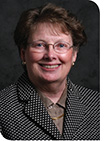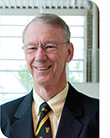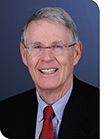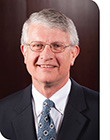 Leo Morton
Leo Morton
University of Missouri–Kansas City
A career educator he’s not—or at least he wasn’t, until Dec. 15, 2008. But when the University of Missouri–Kansas City came calling, Leo Morton was ready to shift gears from corporate suites to academic administration. “What made it such a great fit for me,” UMKC’s chancellor says, “was the way that this entire community—business leaders, political leaders, the education community, the non-profit sector and the scientific-medical community—has embraced the mission of taking our university to a world-class level. With so many terrific people and organizations on board, pulling in the same direction, it was an irresistible opportunity.”
After 41 years in management at places like AT&T Microelectronics, Bell Laboratories, General Motors, Rust Engineering Co., Corning Glass and Aquila, Morton is now working to elevate UMKC as Kansas City’s university: “A public, urban research institution that our community can call its own,” he says. “An opportunity to serve UMKC is an opportunity to serve the entire Kansas City community.”
He counts among his blessings the inheritance he received from Day One—the presence of a Henry W. Bloch School of Management, an accomplished faculty, strong partnerships with the business community and a next-door neighbor like the Ewing Marion Kauffman Foundation, for starters.
“No one succeeds alone,” he modestly says, but “what I’ll take credit for is the role I played in helping to assemble and keep an outstanding team of leaders, educators, researchers and visionaries who are making great things happen here.”
Morton is particularly proud of enrollment growth and improved graduation rates. “It took a lot of time, effort and investment to make that happen,” he says. But the university has also added new residence halls, a new student union building and soccer stadium, all key parts of its repositioning as a destination university for four-year students, not just a “city” college. The new Miller Nichols Learning Center, Henry W. Bloch Executive Hall and Atterbury Student Success Center have also given students the tools they need to reach their full potential, Morton says.
Where UMKC goes from here, he says, will depend on the resources available to fuel its growth. “We have made great strides in improving our performance while state appropriations have declined, and still kept tuition and fees at reasonable levels, as our Best Value ranking attests,” Morton says. “The generosity of local philanthropists and non-profits, and our faculty’s performance at earning grants, have been invaluable.” But the dollars can be stretched no further, and philanthropy is not a bottomless well, he says: “So the challenge for us in the years ahead is to find ways to get the resources to fulfill our university’s, and our community’s, great potential.” Which, in his mind, is something of an imperative: “The status quo,” Morton says, “won’t get it done.”
 Sister Marie Joan Harris
Sister Marie Joan Harris
Avila University
Over the course of 42 years at Avila University, Sister Marie Joan Harris has been able to touch thousands of students’ lives as both a classroom teacher and an administrator. One of those thousands, an immigrant from Nigeria finding his way in a new country, still stands out today. He was a chemistry major who would seek her counsel on a lot more than just chemistry, because Avila, she said, was like a family to him here.
“He earned a Ph.D. and has gone on to hold positions in several companies where he has acquired over a hundred patents for his work in pharmaceuticals and health-related research,” Sister Marie says. “He was recently honored by Avila as one of our outstanding alumni. I feel honored to have played a small role in his success.”
Now multiply that experience by a factor of several thousand, and you begin to understand the bond between student, institution and leader. Sister Marie is provost and vice president for academic affairs, rising to that rank after joining the college in 1970, just as she was finishing up her doctorate in analytical chemistry at KU.
Her fondness for teaching—“I began teaching swimming when I was 13 years old and knew that teaching was something I wanted to do,” she says—carried over when she joined the Sisters of St. Joseph of Carondelet. “I knew that I would be in a classroom, but did not imagine that I would teach at the university level,” she says. But she indeed worked in a university classroom for 17 years before the administrative offices beckoned, first as department chair for natural sciences and math, then as vice president and dean for academic affairs before taking her current role.
“As a professor, I believe that I not only taught students to be excellent scientists and health professionals but also to discover their unique gifts and talents,” she says. “As an academic administrator, I am proud of the quality of the faculty that I have played a role in hiring and the quality of the curriculum that we have developed. I have tried to create a very collaborative environment that supports creativity in the classroom enriched by scholarship and service.”
All of that might have been possible by other means, but not quite the way it unfolded in a religious vocation. “I entered the community of the Sisters of St. Joseph because I felt called to make a difference in this world,” Sister Marie says. “As I near the end of my career, I know that in a small way I have done so through the opportunity to teach and serve at Avila University.”
Her passionate belief in the value of a quality education made it “a privilege to watch Avila University grow and to grow with it,” she says. “Over the years I have seen the difference that has been made in so many of our students’ lives and subsequently in our society because of their many contributions.”
 Jerry Davis
Jerry Davis
College of the Ozarks
A full 25 years before the issue of student loan debt became a significant national concern, Jerry Davis became president of College of the Ozarks, looked at the dynamics of funding a college education and said, in effect: The Bucks Stop Here.
Fiercely committed to a goal of providing a first-class liberal arts education to students—and sending them off to their careers without the burden of educational loans—Davis has created an operating model that few academic institutions in America can replicate. Instead of debt-driven growth, he set about building an endowment program that today totals more than $350 million, and putting students to work with jobs on campus to pay down the costs of the tuition, room and board.
“I remember having to work and borrow my way through college,” Davis says. “The borrowing was a burden, and I never forgot this.” So he’s made it a personal mission to help the 1,500 students at College of the Ozarks. “Students need to spend more time worrying about academics than worrying about accumulating a mountain of debt,” he insists.
The product of a broken family and a hardscrabble youth—Davis recounts his story in a book of essays titled “Good Work”—he overcame countless obstacles to earn a doctorate in education. At age 33, he became president of a small, financially struggling liberal-arts college in Kentucky, and set about to turn it around over the next 11 years before taking his current position in Point Lookout, Mo.
Building the endowment was key to making the model work, Davis says. “The endowment of the college is really a ‘tuition replacement fund’ that enables students to participate in a unique work-education program rather than pay tuition,” he said. The fund grew over the years because of gifts from those who believe in the operating philosophy of the college, he said: “People don’t give us money to be like everybody else. It is the philanthropy of the American people that makes the College of the Ozarks possible.”
A man of bedrock faith and ironclad patriotism, Davis is also a proponent of character development, and founded the Keeter Center for Character Education to foster that goal. It has drawn the likes of Israel’s Benjamin Netanyahu and George W. Bush as speakers, and Davis’ clout has been able to bring conservative thought leaders like Margaret Thatcher, Elizabeth Dole, Newt Gingrich and Sarah Palin to the campus near Branson.
“The college has chosen a leadership role in the character education movement,” Davis says, “because the character of young people needs to be strengthened to offset a culture that has been degraded.”
He and his wife, Shirley, have raised three sons.
 Richard Simpson
Richard Simpson
University of Kansas
The first time he was exposed to children with autism, Richard Simpson was a KU doctoral student with undergraduate and master’s degrees in psychology. He wasn’t a special-needs educator—yet. But the hook was set: “I was both fascinated and spellbound by these children with autism,” he recalls. His work in a demonstration program at the KU Med Center also connected him with what he remembers as an “amazingly talented group of professionals.”
“These colleagues were my mentors, and they taught me more than I could possibly describe about children with special needs, and in particular children and youth with autism,” says Simpson, a professor of special education at KU. Not only did he establish what is generally regarded as the nation’s first autism-focused course of study—one consistently ranked as the nation’s best—he’s authored or co-authored hundreds of scientific journal publications on autism and other developmental disabilities.
“When I first entered the field, autism was considered to be a relatively rare disorder,” he recalls. “The prevailing notion at that time was that autism occurred about three to five times per 10,000 children.” The Centers for Disease Control, however, currently estimates the rate of autism spectrum disorders at one in 88 children overall, and one in 54 males.
Part of that rise isn’t an increase in frequency at all, but comes from a better understanding of what constitutes those disorders. Simpson’s work has played a role in that increasing awareness. “I think I am most proud that I was able to offer a training program specifically in the area of autism for a sustained period of time,” he says. Since founding KU’s program, “my colleagues and I have prepared literally hundreds of teachers and related service professionals to work with students with autism,” he said. He’s also founding editor of the professional journal Focus on Autism and Other Developmental Disabilities, a peer-reviewed publication. “Over the nearly three decades of its existence, the journal has disseminated practitioner-oriented information and research related to serving individuals with ASD to countless professionals and parents,” Simpson says.
But in the end, it’s all about improving lives. “I took great delight,” he says, “in observing the positive outcomes that accrued when a well-trained multidisciplinary staff used effective practice methods in a coordinated fashion, particularly when these methods were individually orchestrated in accordance with family needs, preferences, and resources.”
For nearly half a century, he’s been deeply bound to KU. “I am both a KU degree-holder and a KU employee. My wife also holds a Ph.D. degree from KU. It is a great place to work and I have been fortunate to have been given an opportunity to call it my home.”
 Ron Trewyn
Ron Trewyn
Kansas State University
At some point—he’s not sure yet just when—Ron Trewyn will have to answer the retirement siren’s song. Before he does, though, he’s committed to one thing: Seeing construction wind down, if not completed, on the National Agro and Bio Defense Facility under way in Manhattan, adjacent to Kansas State University.
Trewyn, most recently the vice president for research at K-State, is now the university’s liaison with federal officials involved in a national-security project with a billion-dollar price tag. After 20 years on the campus, it’s fitting that Trewyn’s final assignment is, as he calls it, “a once in 10 lifetimes opportunity.”
“I’ve committed a lot of my years here to NBAF,” he says. “I want to stick with it for a while, at least see it on the way to becoming a reality.” That’s still five years of construction time—and $300 million in federal outlays—away, but the central utility plant is up, and when the project is finished, Trewyn says, “I really think NBAF will be, as far as infectious diseases, the go-to place certainly in the country, but probably broader than that, in the world, for this type of research.”
It’s not the kind of conclusion to a career—or careers, for that matter—that he’d envisioned as a marine biology student at the University of Hawaii, or at business school courses in accounting, before becoming the first college graduate in his family, with a biology degree from Wisconsin–Whitewater. He also was able to tour Vietnam on taxpayer expense, and still carries a piece of metal in one lung from that infantry experience.
After earning a doctorate in microbial physiology, biochemistry and genetics at Oregon State, he spent nearly 20 years in cancer research at Ohio State’s medical school. Research became his passion, and even though he can’t pinpoint the source of that passion, he knew he’d found his calling. Then he moved into research administration because he “wanted to make it happen, facilitate that for others.”
After joining K-State in 1994 as associate vice provost for research, Trewyn had a front-row seat in a series of fortuitous developments that would eventually lead to NBAF. “In 1999, we put together institutionally the big Homeland Defense Food Safety and Security Emergency Preparedness Program, which predated 9/11, looking at threats in this area,” Trewyn says. “What we proposed back then, 100 pages of stuff we pulled together with faculty across the institution, looked at a worldwide threat to the food supply.” After Sept. 11 and the anthrax attacks of 2001, “that ultimately led to building the Biosecurity Research Institute here,” and with that in place, K-State had a huge advantage in the ensuing, fierce competition for NBAF.
Companies doing contract research and positioning themselves to align with a premier research facility are already gravitating toward Manhattan, he says, and Trewyn is convinced that much, much more is to come: “They can see,” he says “that this is where the action is going to be.”
 Andy Tompkins
Andy Tompkins
Kansas Board of Regents
There’s been a lot of talk since the Great Recession about whether a college degree still has the value proposition today that it did before student debt levels hit the trillion-dollar mark. Andy Tompkins is having none of it. “The value of a higher education credential or degree is even more important to a person’s future prosperity than when I graduated from college in 1969,” says the president of the Kansas Board of Regents. “At that time, many jobs did not require higher education,” he says.
But the statistics today are debate-killers: Tompkins cites a study by the Georgetown Center for Education and the Workforce, which notes that Kansas will need more than 60 percent of its workers with a credential, associate, or bachelor’s degree by 2018. “Our data indicate that we have approximately 42 percent of our population with an associate degree or higher, and another 10 percent with a postsecondary certificate or credential,” Tompkins says. “So we have a ways to go to help Kansans meet the projected work-force needs.”
And he’s in a position to do something about that. Since 2010, Tompkins has been president and CEO of the state’s policy-setting board for higher education. He brings to that role a career-long perspective steeped in both K–12 and post-secondary education—from high school teacher, principal, superintendent and state education commissioner to university professor, department chair and dean.
“What I hope I have added during my service is a passion for education and a vision for believing in the potential of all Kansans to learn and make a contribution to improve their own circumstances as well as those around them,” Tompkins says.
He made the leap from K–12 schools to higher education in 1994, taking a position in the college of education at Pittsburg State University, eventually rising to dean, and also taught leadership and policy studies for the school of education at KU.
Those duties have given him a keen appreciation for the role of higher education. “We know that the more education a person has, the greater their lifetime earnings and the less likely they are to be unemployed,” Tompkins says. “I am especially pleased to see a greater appreciation for and interest in postsecondary technical education because it is a vital part of meeting our work-force needs and the vocational interests of Kansans.”
And, he says, education isn’t a one-way street: “I have learned a lot,” he says, “since I assumed a leadership role at the Kansas Board of Regents,” which oversees the seven state universities and 19 community colleges in Kansas. “Our role as leaders is to build for the next person by adding the value we can so that when the next person assumes the role, the organization can capitalize on that person’s strengths.”